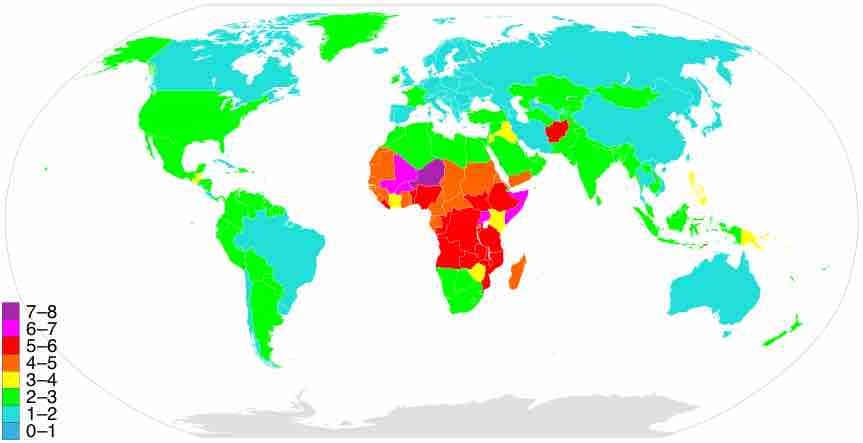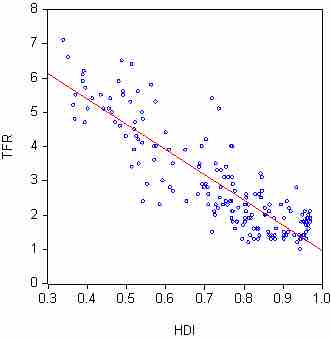In demography, fertility refers to the actual production of offspring, rather than the physical capability to produce, which is called fecundity. To estimate how quickly a population is growing, demographers must know how frequently people are added to the population by being born, so they measure fertility. There are a number of different approaches to measuring fertility rate—such as crude birth rate (CBR), general fertility rate (GFR), child-woman ratio (CWR), total fertility rate (TFR), gross reproduction rate (GRR), and net reproduction rate (NRR).
Period Measures
Crude birth rate (CBR) is the number of live births in a given year per 1,000 people alive at the middle of that year. General fertility rate (GFR) is the number of births in a year divided by the number of women of childbearing age (usually 15 to 49 years old, or sometimes 15 to 44 years old), times 1000. It focuses on potential mothers only, and takes the age distribution into account. Child-Woman Ratio (CWR) is the ratio of the number of children under 5 to the number of women 15-49, times 1000.
Cohort Measures
Age-specific fertility rate (ASFR) is the number of births in a year to women in a 5-year age group, divided by the number of all women in that age group, times 1000. The usual age groups are 10-14, 15-19, 20-24, etc.
Total fertility rate (TFR) is the total number of children a woman would bear during her lifetime if she were to experience the prevailing age-specific fertility rates of women and survive until the end of her reproductive life . TFR equals the sum for all age groups of 5 times each ASFR rate. The TFR is a synthetic rate, not based on the fertility of any real group of women since this would involve waiting until they had completed childbearing. The TFR represents the average number of children a woman would have were she to fast-forward through all her childbearing years in a single year, under all the age-specific fertility rates for that year.

Total Fertility Rate
This map shows countries coded by total fertility rates, with 0-1 children at the bottom of the spectrum and 7-8 at the top. A number of factors, such as development index and religious tradition, contribute to variations in fertility rates.
The TFR (or TPFR—total period fertility rate) is a better index of fertility than the crude birth rate because it is independent of the age structure of the population, but it is a poorer estimate of actual completed family size than the total cohort fertility rate. In particular, the TFR does not necessarily predict how many children young women now will eventually have, as their fertility rates in years to come may change from those of older women now.
Gross reproduction rate (GRR) is the number of girl babies who would be born to a woman completing her reproductive life at current age-specific fertility rates. It assumes that all of the baby girls will grow up and live to at least age 50. Like the TFR, the GRR ignores life expectancy. It assumes that all women will survive at least until the end of their reproductive lives.
Net reproduction rate (NRR) starts with the GRR and adds the realistic assumption that some of the women will die before age 59; therefore they will not be alive to bear some of the potential babies that were counted in the GRR. NRR is always lower than GRR, but in countries where mortality is very low, almost all the baby girls grow up to be potential mothers, and the NRR is practically the same as GRR.
Factors Impacting Fertility
Human fertility depends on a long list of factors, including physical health and nutrition, sexual behavior, culture, instinct, endocrinology, timing, economics, way of life, and emotions. Fertility rates vary among countries and cultures because these factors vary. Demographers study the factors that affect fertility in order to better understand fertility patterns and their variance. Three of the major categories they study are physical health and nutrition, sexual behavior and human fertility, and political issues regarding childbirth and childrearing.
Population Control
The birth rate is an issue of concern for many governments and policymakers. Some, including those of Italy and Malaysia, seek to increase the national birth rate using pronatal measures such as financial incentives to new mothers. Conversely, other countries have policies to reduce the birth rate, such as China's former one-child policy.
In some places, government policies have been focused on reducing birth rates by improving women's sexual and reproductive health and rights. Typically, high birth rates have been associated with health impairments and low life expectancy, low living standards, low status of women, and low levels of education. There are claims that as countries go through economic development and social change, birth rate declines. Indeed, demographers consistently find that one of the strongest predictors of fertility rates is women's educational attainment. Almost universally, higher levels of educational attainment correspond to lower fertility rates.

Fertility Rate and Human Development Index
Fertility has been found to correlate to human development index, with more developed countries having lower fertility rates than less developed ones.